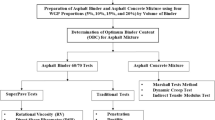Abstract
The present study explains the effect of aggregate gradation on moisture damage in bituminous mixes. Three types of aggregate gradation, two types of binder; VG-30 and Polymer modified bitumen (PMB-40) and two types of mixes Bituminous Concrete (BC) and Dense Bituminous Macadam (DBM) are used. Moisture susceptibility tests like retained stability and tensile strength ratio are conducted on Marshall specimens. The static creep test was also conducted for conditioned and unconditioned specimens to observe the effect of moisture on creep behaviour. The results indicate that Marshall stability and flow values are higher in PMB-40 mixes than in VG-30 mixes. Moisture susceptibility of PMB-40 mixes is low when compared with mix using VG-30. The reduction in retained stability, and Indirect Tensile Strength (ITS) and increase in creep are evaluated for finer, coarser and normal gradation of aggregates to observe the effect of gradation on moisture susceptibility of mixes. The retained stability is least affected when compared with other moisture susceptibility parameters. Also, gradation parameters s1 and Gradation Ratio (GR) are introduced in this paper to establish relation between aggregate gradation and moisture susceptibility and permanent deformation. Models are suggested to estimate rut depth from ITS and stability values.
Similar content being viewed by others
References
AASHTO T-283 (1989). Resistance of compacted bituminous mixture to moisture induced damage, American Association of State Highway and Transportation Officials (AASHTO), Washington, D.C.
Abo-Qudais, S. A. (2007). “The effects of environmental damage evaluation techniques on the prediction of environmental damage in asphalt mixtures.” Science Direct, Building and Environment Journal, Vol. 42, pp. 288–296.
Abo-Qudais, S. A. and Haider, H. A. (2007). “Effect of antistripping additives on environmental damage of bituminous mixtures.” Science Direct, Building and Environment Journal, Vol. 42, pp. 2929–2938.
ASTM D 1559 (1989). Resistance of plastic flow of bituminous mixtures using marshall apparatus, American Society for Testing and Materials.
Brown, E. R. and Bassett, C. E. (1989). The effects of maximum aggregate size on properties of asphalt aggregate mixes, Report submitted to Highway Research Center, Harbert Engineering, Auburn University, Alabama, USA. p. 53.
Cominsky, R., Leahy, R. B., and Harrigan, E. T. (1994). Level one mix design: material selection, compaction, and conditioning, Report SHRP-A-408, Strategic Highway Research Program, National Research Council, USA.
Eliana, P. and John, E. P. (2006). HMA Pavement performance and durability, Joint Transportation Research Program, School of Civil Engineering, Purdue University, USA, p. 7.
Hicks, R. G. (1991). “Moisture damage in asphalt concrete.” NCHRP Synthesis of Highway Practice 175, Transportation Research Board, National Research Council, Vol. 121, pp. 92–99.
IS 73 (2006). Paving bitumen specifications, Bureau of Indian Standards, New Delhi, India.
IS 15462 (2004). Polymer and rubber modified bitumen specifications, Bureau of Indian Standards, New Delhi, India.
Kandhal, P. S. (1992). Moisture susceptibility of HMA mixes: Identification of problem and recommended solutions, NCAT Report No. 92-1, National Centre for Asphalt Technology, p. 11.
Kennedy, T. W., Roberts, F. L., and Lee, K. W. (1982). “Evaluation of moisture susceptibility of asphalt mixtures using the texas freezethaw pedestal test.” Association of Asphalt Technologists, Vol. 51, pp. 327–341.
Kumar, P., Chandra, S., and Bose, S. (2006). “Strength characteristics of polymer modified mixes.” International Journal of Pavement Engineering, Vol. 7, No. 1, pp. 63–71.
Pan, C. L. and White, T. (1999). Conditions for stripping using accelerated testing, FHWA/IN/JTRP-97/13, HPR-2068, Indiana Department of Transportation. p. 32.
Peter, E. S. (2007). Comparison of lime and liquid additives on the moisture damage of hot mix asphalt mixtures, Prepared for the National Lime Association, Reno, Nevada. USA, p. 17.
Roberts, F. L., Kandhal, P. S., Brown, E. R., Lee, D., and Kennedy, T. (1996). “Hot mix asphalt materials, mixtures, design, and construction.” NAPA Education Foundation, Lanham, Maryland, Second Edition, pp. 241–250.
STP 20. (1993). “Retained marshall stability.” Standard Test Procedures Manual, Saskatchewan Highways and Transportation, pp. 1–2.
Author information
Authors and Affiliations
Corresponding author
Rights and permissions
About this article
Cite this article
Habeeb, H., Chandra, S. & Nashaat, Y. Estimation of moisture damage and permanent deformation in asphalt mixture from aggregate gradation. KSCE J Civ Eng 18, 1655–1663 (2014). https://doi.org/10.1007/s12205-014-1356-7
Received:
Revised:
Accepted:
Published:
Issue Date:
DOI: https://doi.org/10.1007/s12205-014-1356-7




